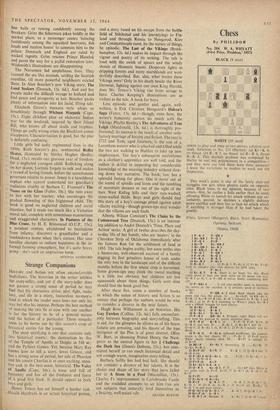Chess
By PHIL1DOR No. 204. W. A. WHYATT (First Prize, 'Problem,' 1957)
BLACK (9 men) WHITE (10 men) WHITE to play and mate in two moves; solution next week. Solutions to No. 203 (Harley): (a) Kt—K 4, no threat. (b) B---B 7, no threat. (c) R—R 6, threat B—K 6. This devilish problem was composed by Harley to sort out prizewinners in a competition-- and they were not told there were three answers! I -leave the variations to readers to work out for themselves.
•
This week's game is one of the fairly clear-cut. struggles one gets when players castle on opposite sides. Black loses, in my opinion, because of two errors—first, he castles a little earlier than he need, allowing White to launch his attack without any un- certainty, second, he declines a slightly dubious pawn sacrifice and then has to face an attack which if anything is stronger than if he had taken the gambit.
1Vhile, SilLAGY (Hungary). Black, NACU (Rumania). Opening, SICILIAN.
(Sinaia, 1964)
1 P—K 4 P—QR 4
2 Kt---KB 3 P—Q 3 3 P—Q 4 PXP 4 Kt xP Kl---1111 3 5 Kt—Q11 3 Ke—B 3 6 8—.KKt 5 P—K 3 7 Q—Q 2 P.- Q11 3 8 0-0-0 B---Q 2 9 P.---B 4 B--K 2 10 Kt.--B 3 P--K, 4
leads to complex play with chances for both sides.
11 B—Q 3 . . . II P—K 5, P—Kt 5; 12 PxKt. P xKt 11 . . P—Kt 5 12 Kt--K 2 0-0, There Is no hurry for this: Black could spend at least one more move on his queen side (e.g. Q-13 2 or Kt 3 or P—QR 4) before finally committing him- self.
13 P—KKI 4 . . . it will take another game to determine the merits of this sacrifice: it is certainly good if declined, as here.
13 . . P—QR 4. 11 think Black should take the Pawn and face the attack: 13 . . . Kt xKtP; 14 KR—Kt 1, 8X B; 15 Ktxll R xKt, B—R 1 followed by P—Kt 3 and B—Kt 2 or by P—K 4 according to Whites play), KI.-13 3 with a difficult struggle for both players.
14 BxKl 8 X B 15 P—Kt 5 B—K 2
16 K—Kt Q—Kt 3 17 P—B 5 KR—Kt I. Probably right: Black -will not now hold his position by purely defensive play. 18 P--B 6! R—B I. 18 ... PxP: 19 PXP, BXP; 20 Q—R 6! and now 20 . . . B—Kt 2; 21 R—Kt 1 and 20 . Q—Q 1; 21 R—Kt 1 ch, K—R 1; 22 P—K 5 equally lost; for Black. 19 P--K 51 P—Kt 6. Although insufficient. this counter- attack is the best chance. -19 . . P—Kt 3; 20 PXP leaves White clearly winning since 20 . . . B. P3 is refuted by 21 B x P. 20 BP XP Kt—Kt 5 threatening 21 . KLXB; 22 QXKt, P-11 5. 21 RxP eh!. K X8. 21 • . . K—R 1; 22 Q—B 4 and 23 Q—R 4 etc. 22 P—Kt 6 chIK—Kt I. 22 . . . PXP; 23 Kt—Kt 5 ch, K—R 1: 24 Q—B 4.
23 PXP ch KXP 24 Kt—Kt 5 ch K—K 1
25 Q—B 4 Kt--Q 4. If 25 .* . KtxRP then White is too quick with 26 Px P. 13X1'; 27 Q-13 7 ch, K—Q I; 28 R x P.
26 P X P1 Kt x Q
27 110--Kt 8-- Q Kt x Kt 211 Rxr Q--B 7. 23 . . 0- -R 2: 29 Q -II 7 oh. K---Q 1; 30 Qx13 ch, K—B 2; 31 Kt x P cli!. Bx Kt; 32 0--K 7 eh and 1114te fOrOWI. 29 Q.—Kt 6 cb K-0 I. 2c . . . K K 2; 30 Q—R 7 a
30 Kt X P ch K--B
31 Q—B 2 ch Resigns. Si . „ K Kt 2: 32 Q - 13 7 15,05.










































 Previous page
Previous page